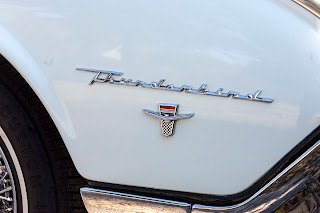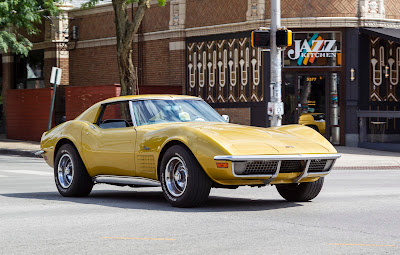All through the Fifties, Detroit's "Big Three" produced pretty much nothing but big cars. Longer, lower, and wider were the watchwords for every model year.
While the various marques of Ford, General Motors, and Chrysler sold varying models in that decade, they were all just variations on the same full-size platforms.
Not every consumer wanted a car that big, though, and they came with other problems. If you live in a neighborhood like Broad Ripple, where many of the garages predate the '50s, you can see the alterations that were made to some garages that had been built during the age of the Model A to allow them to accommodate the much longer new cars. It's also daunting to imagine navigating these narrow streets in a tailfin-bedecked twenty-foot chromasaurus with numb on-center steering and a hood ornament 'way out there in another zip code from the front seat.
The smaller manufacturers like American Motors and Studebaker offered smaller cars, and sales of imports like Germany's Volkswagen began to take off and Detroit realized they were leaving money on the table, so all the Big Three launched compacts in the early Sixties. The Fords and Mopars were fairly conventional shrunken versions of their full-size cars, but Chevy went with something truly different.
The Corvair used an air-cooled horizontally-opposed six cylinder motor mounted aft of the rear axle. In an era of increasingly large V-8s, the 140cid 80hp Turbo-Air six in the 1960 Corvair was a little twee. Note, please, that "Turbo-Air" was just the name hung on by the marketing department; actual turbocharged Corvairs were still a couple years off.
Chevrolet launched the Corvair as a full line of vehicles: Sedans, coupes, convertibles, station wagons, even vans and pickup trucks.
While sales started off briskly, they started trailing off almost immediately. The non-turbo Corvairs were woefully underpowered, handling could be quirky, and the sedan and coupe versions lacked any pillarless hardtops which were very much in vogue at the time. The wagons and pickups had to have higher load floors to clear the engine.
The cars were redesigned for the 1965 model year. The wagons and trucks were dropped, hardtops were added, and the new cars had gorgeous lines, more power, independent rear suspensions...but nobody cared much.
Ralph Nader's book
Unsafe at Any Speed is sometimes credited with the demise of the Corvair, but when it came out in '65, it was basically just throwing dirt on the coffin. Small sedan buyers were buying Falcons and Valiants, while sporty coupe buyers were snapping up Ford Mustangs as fast as Dearborn could churn them out.
Chevy halted further development of the rear-engined oddity and concentrated on their Chevy II compact and the forthcoming Camaro small sporty coupe. The Corvair was left to coast through the 1969 model year before finally getting the axe.
The pictured car is a 1966 Chevrolet Corvair Monza 110 convertible in Regal Red with the 164 cubic inch flat-six in 2x1bbl 110hp trim.
It was photographed in November of 2023 with a 36MP Nikon D800 & 24-120mm f/4 VR zoom lens, so those photos can be embiggenated rather a lot.




















































